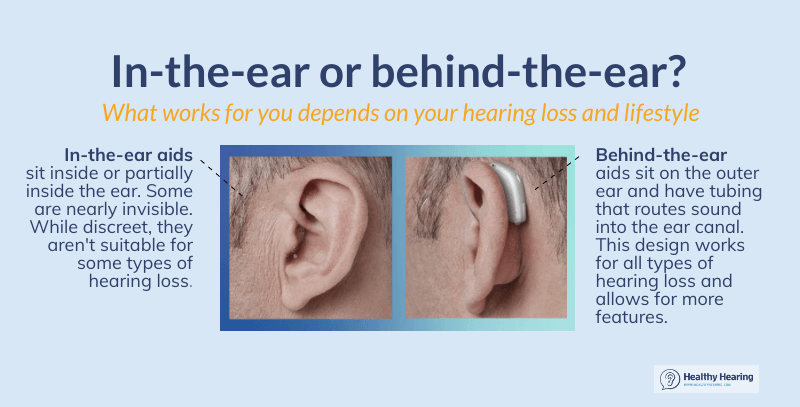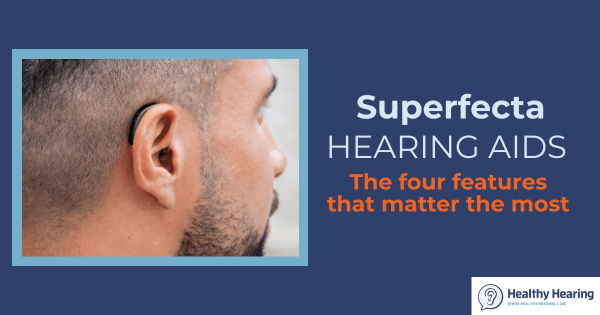|
www.HealthyHearing.com |
Tips for finding the best hearing aidsShopping for a hearing aid? Here are four key features advocates recommend
Contributed by Madeleine Burry Buying hearing aids can be an overwhelming experience. Hearing aid specialists and audiologists are trained to walk you through the options, and help you get fitted with the devices that offer you everything you need (and skip unnecessary bells and whistles that increase the price). Still, it’s always a smart idea as a consumer to be informed. That’s particularly true with hearing aids—with these small devices, people often have to make difficult tradeoffs when it comes to features, says audiologist Juliëtte Sterkens, a consumer and hearing loop advocate for the Hearing Loss Association of America (HLAA). Plus, with so many options available, including over-the-counter hearing aids, knowing which features are musts, and which are optional, can be tricky. Enter a new term, coined by Sterkens, to give you a starting point: superfecta hearing aids. What should you look for in a hearing aid?Consumer advocates agree, the best hearing aids have several key characteristics that help you hear better, are small in size to easily fit in or behind even the smallest ears and make handling them easier for the user. These features are:
It’s tempting to compare hearing aids to glasses. Talk to hearing providers, though, and you can count on them pointing out a key difference: Hearing aids improve hearing, but unlike glasses, they don’t restore hearing. “Hearing aids don’t give you normal hearing,” Sterkens says. Instead, they amplify sounds. That’s why two of the features—Bluetooth and telecoil—are so important, as they can be used in complicated hearing situations to pick up the slack for what a more basic hearing aid can't do. Let's take a look at the four features that make for the best hearing aids: 1. Telecoils for noisy public settingsAlso known as t-coils, telecoils are not a buzzy new technology. In fact, they date back to the 1930s. But these small copper coils within hearing aids do something powerful: They’re a wireless receiver that allows your hearing aid to wirelessly connect to assistive listening systems in public settings, including hearing loops. Telecoil users rave about their ability to hear the sound directly in their hearing aids, Sterkens says. Visit Loop Locator to find hearing loops that work with telecoils. Put simply: If you’re in a big venue that has a hearing loop installed—like the theater, a lecture hall, or a place of worship—you can connect to the audio system by turning on your telecoil. The telecoil is an example of a feature that helps you hear in “public places where hearing aids alone do not deliver,” Sterkens says. Using the telecoil removes the background noise (so you hear the speaker, and not the rustle and hubbub of other attendees), without requiring you to request a receiver. With telecoils on, it’s as if you’re hearing someone from inches away—not an auditorium’s distance. In venues that do not offer hearing loops, ask at the service desk for a wireless FM or infrared receiver with a neckloop.
Think of the combination of hearing loops and telecoils as the original streaming technology, Sterkens says. “I can definitely tell that I can hear better with it turned on,” says Doug Austin, age 73, of Oshkosh, Wis. Austin takes advantage of the built-in t-coils in his hearing aid in auditoriums in Oshkosh that have the loop system set up. In his retirement community, many of the gathering places have hearing loops, including meeting rooms (where sometimes chefs do demos), a performing arts center that hosts speakers and bands, as well as religious services. Previously, some hearing aid manufacturers removed telecoils to make the devices smaller. But with superfecta hearing aids, the t-coils are available—as well as other features that consumers benefit from. TIP: Learn more about hearing loops—and how to advocate for them in your community—with this toolkit from HLAA. 2. Bluetooth connection for seamless streaming sound“Bluetooth technology permits direct streaming of sound from personal devices,” Sterkens says—so you can hear what’s playing on your TV or the person speaking on your smartphone directly in your hearing aid. “Consumers rave about it. They love it,” Sterkens says. With Austin’s first set of hearing aids, he had to wear a special device around his neck to harness the Bluetooth connection—if he got a phone call, he’d need to wear it and switch it on. Things are simpler with his latest hearing aids: When a call comes through, all he needs to do is touch a button on his hearing aids and he’s instantly connected. With it, he hears so much better. He has a pretty good soundbar on his TV, but “when I have it [the sound] going directly in my hearing aids, it’s just much clearer,” Austin says. That’s also true for the telephone, too: There’s a “world of difference” when phone calls come through his hearing aids, he says. 3. Rechargeabilityaids over hearing aids that use disposable button batteries. Rechargeable hearing aid batteries have now become quite common, and based on how much consumers love them, Sterkens thinks they should be routinely offered. According to a March 2021 survey in Consumer Reports, 53 percent of hearing aid wearers prioritize rechargeable devices. It’s mainly a convenience factor: Rechargeable devices “don’t help you hear any better,” notes Sterkens. They are easy to handle, which makes them appealing for people with dexterity problems. However, they do have some downsides to consider. For example, you have to bring the charger with you while traveling, and you need steady access to electricity. 4. Small form factor (discreet design)There are many types and styles of hearing aids. But in the most general terms, hearing aids are either in-the-ear (ITE) hearing aids or behind-the-ear (BTE) hearing aids, with different subtypes within those categories. “The fourth part of the superfecta is that it comes in a small and cosmetically appealing package,” Sterkens says. People prefer smaller, less visible, more discreet options for hearing aids, which also work well for people with small ears. You might think that means she recommends ITE hearing aids, but due to their size, they often lack advanced features. Better options are small "mini" styles worn behind the ear, which are often available in a variety of skin or hair tones to blend in. 
Other hearing aid features you may wantOf course, hearing aids offer many features beyond these four. A conversation with your hearing care provider can help you figure out which ones make sense, given your hearing loss and situation. Some hearing aid technology features to keep in mind:
Be patient with yourself and take the time to carefully research your hearing aid. There are so many options—different styles, sizes, and levels of technology, Sterkens says. “By the time the consumer walks out of the [audiologist’s] office, their head is spinning.” In general, OTC hearing aids, which are limited in function and use, won't have as many features as hearing aids available at hearing clinics. Take time to learn about hearing loss, tooDealing with hearing loss can be frustrating. Getting educated can reduce the stress levels. Explore blogs by well-known consumer advocates such as Shari Eberts, read books such “Smart Hearing” or “Hearing Loss for Dummies.” They all offer well-researched information and practical tips for dealing with hearing loss, including advice on OTC hearing aids. You can also learn more by exploring the website from the nonprofit Hearing Loss Association of America (HLAA) or by attending a couple of their support chapter meetings. “Whether buying hearing aids from a professional or over-the counter, you will want to make sure you get a hearing aid that can help you everywhere, that will permit you to hear everywhere,” Sterkens says—with no compromises, she adds. To find a provider near you, visit our directory of consumer-reviewed hearing clinics near you. Madeleine Burry
Related Help Pages:
Hearing aids Types of hearing aids Technology Bluetooth Fitting Reviews and comparisons Batteries Accessories
|
Featured clinics near me
Earzlink Hearing Care - Reynoldsburg
7668 Slate Ridge Blvd
Reynoldsburg, OH 43068

Find a clinic
We have more hearing clinic reviews than any other site!



.jpg)
 Madeleine Burry is a Brooklyn-based freelance writer and editor. She's written about health for several online publications, including Women's Health, Prevention, Health, Livestrong and Good Housekeeping. You can follow her on Twitter @lovelanewest.
Madeleine Burry is a Brooklyn-based freelance writer and editor. She's written about health for several online publications, including Women's Health, Prevention, Health, Livestrong and Good Housekeeping. You can follow her on Twitter @lovelanewest.